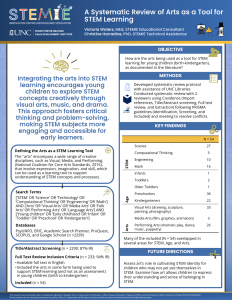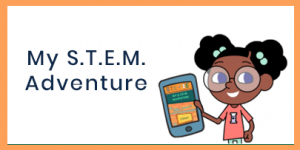Supporting Young Children’s STEM Learning with the Arts
Posted on April 10, 2025 in Insights, Practice

The integration of arts into STEM education can enhance young children’s learning experiences by making complex concepts more engaging and accessible.
The Arts—like drawing, music, and dance,—can be powerful tools to support young children‘s STEM learning (Okwara & Henrik Pretorius, 2023; Ghanbari, 2015). STEMIE recognizes that the Arts are their own unique area of learning (National Art Education Association, 2023), separate from science, technology (computational thinking), engineering, and math (STEM). The arts include various forms of expression, such as visual, media, and performing. At STEMIE, when we talk about using the arts in early childhood STEM education, we are talking about blending creativity with learning skills (Root-Bernstein, 2015) to make STEM concepts more engaging and meaningful for young children (Land, 2013).
Why Combine the Arts with STEM?
Combining the arts with STEM, or arts integration, provides young children access to STEM learning opportunities in creative and hands-on ways. This integrated approach helps young children use their imagination and curiosity to think critically, problem-solve (Tsurusaki et al., 2017; Turkka et al., 2017) and communicate ideas. Using the arts makes STEM concepts feel accessible and exciting, which encourages young children to explore more and build a positive identity in STEM. (Waters & Harradine, 2024)

How Can the Arts Support STEM Learning?
Visual Arts: Drawing, Painting, Photography, and Sculpting
Activities like drawing or painting allow young children to express STEM ideas visually. For instance, drawing a plant’s life cycle or painting animals and their habitats helps young children understand science concepts in a way that feels natural to them. Building with playdough or creating sculptures can introduce early engineering and spatial skills, as young children explore how materials come together. Using simple cameras or creating flipbooks lets young children explore STEM concepts. They can take photos of shadows throughout the day to learn about light and time or make a flipbook that shows the moon’s phases.
Activities like drawing or painting allow young children to express STEM ideas visually, helping them to process and understand concepts creatively. A key part of this is the child-level process of documentation, where young children record what they observe and experience through various forms of art. This might involve making marks on paper, creating models from playdough or blocks, drawing, painting, or even making simple graphs. Documentation helps young children collect and share their findings, and they may use materials to show measurement or create audio and video recordings to capture their thoughts. This process not only builds understanding but also gives young children a sense of ownership over their learning as they create visual “records” of their STEM explorations.
Media Arts: Film, Graphics, and Animation
Media arts involve using technology to create and share artistic works, with exciting areas like video and animation. With video and adult support, young children can capture images to tell stories. For example, they can create a time-lapse movie of the water cycle by taking a series of photos over time as water evaporates, forms clouds, and falls as rain. This activity helps them visualize and understand how the water cycle works in nature. (Fridberg et al., 2017)
Animation is another fun way to explore media arts. Kids can create animated art to solve problems, using their computational thinking skills. For instance, they might design and build a house in an animation, showing how each part of the house is constructed step by step. This sparks their creativity and encourages them to think critically about the design process. (Leung et al., 2024)
 Another great tool to enhance this process is STEMIE’s “My STEM Adventure” app. This interactive, accessible app allows young children to create their own digital stories based on their STEM explorations. As they engage with the app, they can combine text, images they take, and audio to narrate and document their adventures in STEM. This not only cultivates creativity and self-expression but also encourages young children to share their learning experiences in a fun and engaging way, making STEM concepts more relatable and memorable.
Another great tool to enhance this process is STEMIE’s “My STEM Adventure” app. This interactive, accessible app allows young children to create their own digital stories based on their STEM explorations. As they engage with the app, they can combine text, images they take, and audio to narrate and document their adventures in STEM. This not only cultivates creativity and self-expression but also encourages young children to share their learning experiences in a fun and engaging way, making STEM concepts more relatable and memorable.
Performing Arts: Music, Dance, Dramatic Play, and Puppetry
Music, dance, and dramatic play provide young children with a playful way to learn STEM concepts. Clapping to a rhythm or moving to a beat helps young children understand patterns and sequences. Puppetry and dramatic play, such as pretending to be an astronaut or a scientist, gives young children a chance to act out STEM roles and concepts, building their interest and identity in these fields.
Cultivating STEM Learning Through the Arts
For many young children, the arts create a sense of connection to STEM by allowing them to express themselves in comfortable and enjoyable ways. When young children create, act, or share stories around STEM ideas, they start to see themselves as capable “STEM thinkers” and “STEM doers.” Engaging in these creative activities can help build a sense of belonging in STEM for young children who may not see themselves in STEM roles.
Tips for Early Childhood Educators
- Encourage Creativity: Let young children explore and make their own connections between art and STEM.
- Celebrate All Ideas: Each child’s creative expression is unique, and every idea is a step in STEM learning.
By integrating the arts with STEM, early childhood educators can create joyful, inclusive experiences where young children feel successful and excited to explore and learn. The arts make STEM concepts more relatable, helping all young children see that they have a place in the world of STEM.
Resources:

Educational Consultant at UNC's FPG Child Development Institute and Outreach Manager for STEM Innovation for Inclusion in Early Education Center (STEMIE).

Technical assistance specialist at the UNC Frank Porter Graham Child Development Institute
Especialista de PD en el Centro de Innovación CTIM para la Inclusión en la Educación Temprana (STEMIE)
Fridberg, M., Thulin, S., & Redfors, A. (2017). Preschool young children’s Collaborative Science Learning Scaffolded by Tablets. Research in Science Education, 48, 1007–1026.
Ghanbari, S. (2015). Learning across disciplines: A collective case study of two university programs that integrate the arts with STEM. International Journal of Education and the Arts, 16, 1-21.
Land, M. H. (2013). Full STEAM ahead: The benefits of integrating the arts into STEM. Procedia Computer Science, 20, 547-552. doi: 10.1016/j.procs.2013.09.317
Leung, S. K. Y., Wu, J., & Li, J. W. (2024). Young children’s knowledge construction of computational thinking in a play-based classroom. Early Child Development and Care, (194)2, 208-229, doi: 10.1080/03004430.2023.2299405
National Art Education Association. (2023). National Visual Arts Standards. https://www.arteducators.org/learn-tools/national-visual-arts-standards
Okwara, V. U., & Henrik Pretorius, J. P. (2023). The STEAM vs STEM educational approach: The significance of the application of the arts in science teaching for learners’ attitudes change. Journal of Culture and Values in Education, 6(2), 18-33. doi: 10.46303/jcve.2023.6
Patrick, P., Barnes-Lucas, K., & Brown, D. (2010). Dinocenters. Science and Young children, 48(2), 36-39.
Root-Bernstein, R. (2015). Arts and crafts as adjuncts to STEM education to foster creativity in gifted and talented students. Asia Pacific Education Review, 16(2), 203-212. doi: 10.1007/s12564-015-9362-0
Tsurusaki, B.K., Tzou, C., Conner, L.D.C., & Guthrie, M. (2017). 5th–7th grade girls’ conceptions of creativity: Implications for STEAM education. Creative Education, 8(2), 55–271. doi: 10.4236/ce.2017.82020
Turkka, J., Haatainen, O., & Aksela, M. (2017). Integrating art into science education: A survey of science early childhood educators’ practices. International Journal of Science Education, 39(10), 1403–1419. doi: 10.1080/09500693.2017.1333656
Waters, V., & Harradine, C., (2025). A Systematic Review of Arts as a Tool for STEM Learning [PDF]. The University of North Carolina at Chapel Hill, Frank Porter Graham Child Development Institute, STEM Innovation for Inclusion in Early Education (STEMIE). https://stemie.fpg.unc.edu/resource/a-systematic-review-of-arts-as-a-tool-for-stem-learning/


